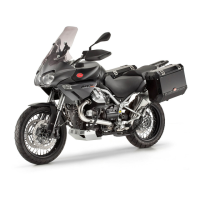
Do you have a question about the MOTO GUZZI Stelvio 1200 8V and is the answer not in the manual?
| Displacement | 1151 cc |
|---|---|
| Fuel System | Electronic fuel injection |
| Transmission | 6-speed |
| Final Drive | Shaft drive |
| ABS | Yes |
| Maximum Power | 105 hp (77 kW) at 7, 500 rpm |
| Maximum Torque | 113 Nm at 5, 800 rpm |
| Rear Suspension | Single shock, adjustable |
| Front Brake | Dual 320 mm discs |
| Rear Brake | 282 mm disc |
| Seat Height | 820 mm |
| Bore x Stroke | 95 x 81.2 mm |
| Rear Tire | 150/70 R17 |
Overview of the manual's content and advice for new owners.
Safety precautions regarding exhaust fumes and carbon monoxide hazards.
Warnings and precautions for handling flammable fuel and refueling safely.
Caution about hot engine and exhaust parts requiring careful handling.
Guidelines for starting the engine and initial riding, including fuel warnings.
Instructions on using front and rear brakes effectively for safe stopping.
Explanation of dashboard warning lights and their meanings for system anomalies.
Safe handling, disposal, and maintenance recommendations for used oils.
Precautions for handling brake and clutch fluids, avoiding surface damage.
Safety warnings about battery electrolyte and hydrogen gas hazards.
Procedures for using the side stand correctly and important safety precautions.
Instructions on reporting vehicle defects that might compromise safety.
Diagram identifying key components specific to the NTX version.
Diagram identifying key components for the standard version.
Overview of the dashboard, instruments, and controls for monitoring vehicle status.
Detailed listing and explanation of instrument panel elements and their functions.
Identification and meaning of various warning and indicator lights on the instrument panel.
Explanation of the digital display layout and standard indications shown.
Description of control buttons for navigating menus and confirming selections.
Explanation of the Antiskid system operation, activation, and deactivation.
Instructions for accessing and using the vehicle's chronometer function.
Guide to accessing and navigating advanced vehicle functions and settings via the menu.
Information on vehicle diagnostics and how to select the display language.
Explanation of service interval indicators and system alarm messages for critical issues.
Description of ignition switch operation, key functions, and steering lock.
Operation of parking lights and the horn button for signaling and visibility.
How to operate the turn signal switch and what a rapidly flashing indicator means.
Explanation of the light switch positions for controlling headlights and tail lights.
Operation of the passing button and heated grips (optional accessory).
How to activate and deactivate the hazard warning lights.
Operation of the engine start button and the emergency stop switch.
Explanation of the Anti-lock Braking System, its benefits, and operation.
Explanation of the Antiskid system for controlling rear wheel spin and improving stability.
Information on the 12V power sockets and their proper usage.
Instructions on how to adjust rider saddle height and remove/access seats.
Instructions for accessing the glove box and tool kit compartment.
Importance of recording chassis and engine numbers and warnings against modification.
Procedure for manually adjusting the vehicle's windscreen.
Information on pre-installation for accessories, specifically side panniers.
Essential checks to perform before riding for safety and proper operation.
Procedure for checking front and rear disc brake operation, fluid, and pads.
Checking throttle operation, smoothness, and engine oil level.
Inspecting wheels, tyres, and ensuring brake levers function smoothly.
Checking clutch operation, lever play, and steering system for smooth movement.
Verifying stands, fastening elements, fuel tank, and electrical switches.
Step-by-step guide for refueling the vehicle's fuel tank safely.
Guide to adjusting rear shock absorber settings for ride quality and load.
Instructions for adjusting the front fork suspension for optimal handling.
Adjusting the clutch lever and guidelines for the engine run-in period.
Information and guidance on starting the engine, especially in cold conditions.
Guidelines for selecting a safe parking spot and securing the vehicle.
Details about the catalytic converter, its function, and maintenance precautions.
Instructions for using side and centre stands, ensuring vehicle stability.
Recommendations and safety tips to prevent vehicle theft.
Essential safety instructions for getting on, off, and riding the motorcycle.
Introduction to maintenance procedures and general warnings about vehicle self-diagnosis.
Procedure for checking engine oil level and adding oil if needed.
Instructions for changing engine oil and oil filter, with safety precautions.
Procedures for checking and maintaining gearbox and final drive oil levels.
Guidelines for checking tyre pressure, wear, and condition, including safety aspects.
Instructions and recommendations for spark plug removal, inspection, and replacement.
Guidance on removing, inspecting, and replacing the air filter.
Procedure for checking brake fluid levels and topping up the system.
How to check and refill the clutch fluid reservoir.
Step-by-step guide for installing a new motorcycle battery, including terminal connection order.
Procedures for checking electrolyte levels and charging the battery, with safety warnings.
Precautions for storing the vehicle during long periods of inactivity to protect the battery.
Information on fuse locations, types, and how to check and replace them safely.
General instructions and safety precautions for replacing vehicle bulbs.
Procedures for checking and adjusting headlight aim according to legal requirements.
Instructions for replacing front indicator bulbs, with safety warnings.
Procedures for disassembling and replacing bulbs in the rear optical unit.
Instructions for replacing rear indicator bulbs, with safety precautions.
Instructions on how to replace the number plate light bulb.
Procedures for removing and adjusting mirrors, including safety checks.
Information on cleaning disc brakes and replacing worn pads for optimal braking.
Measures to take to prevent damage when the vehicle is stored for extended periods.
Guidelines for washing and cleaning the motorcycle, including specific precautions.
Instructions and precautions for safely transporting the motorcycle, including fuel tank emptying.
Specifications for the vehicle's overall dimensions and weight.
Technical details about the motorcycle's engine, including bore, stroke, and capacity.
Details about the diffuser and fuel system, including capacities and electrical components.
Technical data related to the motorcycle's chassis, frame, and suspension geometry.
Details about the front and rear brake systems and transmission specifications.
Specifications for wheels, tyres, and recommended tyre pressures.
List of tools provided with the motorcycle for basic maintenance.
Overview of the importance of scheduled maintenance for vehicle longevity and performance.
General guidelines for routine checks, cleaning, lubrication, and replacements.
Detailed table outlining maintenance tasks at specific mileage intervals.
List of recommended oils, fluids, and grease for vehicle maintenance.
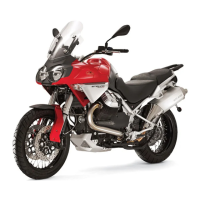

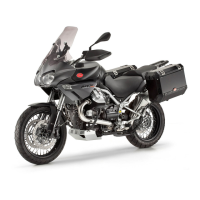
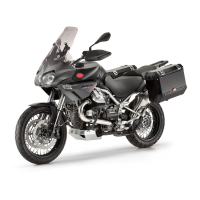
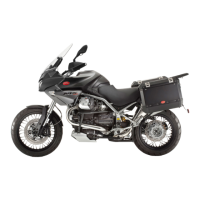
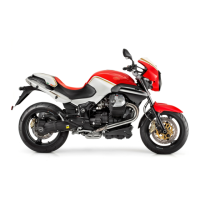

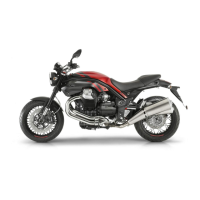
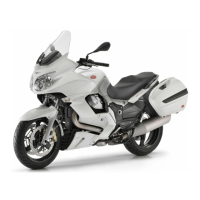
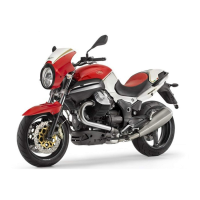
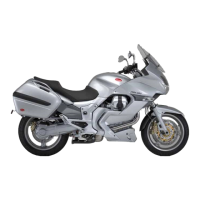
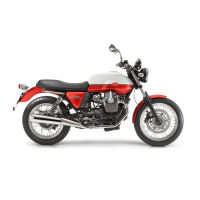
